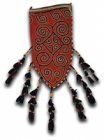Asian Gallery (Toyokan) Room 3
December 12, 2006 (Tue) - March 4, 2007 (Sun)
Afghanistan is a multi-ethnic country east of Iran. The nomads used common fibers such as sheep- or horsehair to spin yarns, dye, and weave it into various utensils: clothing, bags, tent cloths, rugs and decorative bands. Geometric patterns such as represented by diamonds and zigzag patterns, also popular in Japanese culture, are some of the trademarks of Afghan textile art. They are simultaneously thought to carry wishes of fertility, prosperity and peace.
This thematic exhibition focuses on Afghan textile art of the 20th century. Amongst them are tapestries known as Kirim; pile fabrics characterized by its use of feathers that are basic to rug production and were already introduced into Japan during the Edo period (1603 - 1868); felt fabrics made of pressed wool fiber and simply based on the natural tone of sheep wool. They all have been cultivated by the long history and culture of nomadic life and transmit the rich tradition of Afghan textile art to this day.

